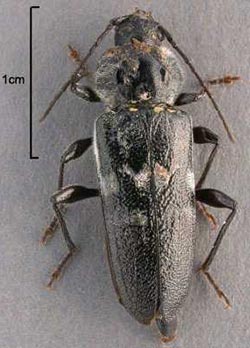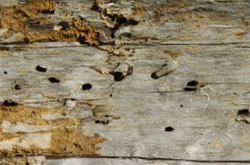European house borer
European House Borer (EHB) (Hylotrupes bajulus), is a destructive pest of untreated seasoned coniferous timber, including pine, fir and spruce (Pinus, Abies, Picea, Araucaria and Pseudotsuga species). It can cause major structural damage to buildings.
Timbers commonly used for structural and joinery purposes in Australia have all been shown to be susceptible to damage by EHB. These include:
- radiata pine
- southern pine
- Douglas fir
- hoop pine
- bunya pine

In Western Australia EHB has been found in susceptible dead trees, logs and living trees with dead wood (dried out damaged branches or trunks).
EHB also infests:
- susceptible roof timbers
- wall frames
- flooring
- architraves
- door frames
It also infests timber articles such as:
- pine furniture
- shipping crates
- pallets
- transport supporting timber and frames
Origin
EHB is found in:
- Europe
- Middle East (Turkey)
- North Africa
- South Africa
- South America
- USA
- China
EHB has been detected several times previously in Australia but these infestations were eradicated by fumigation. In 2004 EHB was detected in Western Australia, and since then has been found in 60 Perth suburbs.
Detecting EHB

The most visible evidence to that pine wood, structural timber or timber articles are infested with EHB is the presence of:
- Adult beetles which are brownish-black to black and have a slightly flattened appearance. The beetle's wings are usually all black and may have distinctive white patches. The top surface of the first body segment behind the head has two raised, black, shiny knobs that resemble eyes. Adults are approximately 18 to 25mm in length with antennae about half as long as the body.
- Characteristic oval-shaped holes, approximately 5 to 10mm in length and running in line with the grain of the timber on the surface of infested timber from which the adult beetle has emerged.
- Frass, which is a mixture of fine powdery particles of wood dust and pellets of excrement — can sometimes be found below the exit holes of infested timber where adult beetles have emerged.
- Long blister-like swellings on the surface of the timber may be evident these are caused by the tightly-packed frass forcing 'out' the thin layer of uneaten wood.

Other evidence to indicate EHB timber infestation includes:
- Soft scraping sounds made by the larvae as they feed. This can often be heard at night and may be audible from some distance.
- EHB larvae within the timber. Larvae are elongate and cylindrical in shape with an enlarged and flattened head. The larvae are between 19 to 41mm long and around 7.5mm wide at maturity. Larvae can be identified by a row of three small black single-lens eyes on each side of the head.
- Galleries (tunnels) within the timber which are formed by the boring larvae and are frequently tightly packed with frass. Galleries within the timber rarely break through the surface of the timber and are therefore seldom detected.
- Batches of up to 120 eggs which are laid in crevices or cracks in timber.
How EHB is spread
EHB has a relatively long larval period which can vary from 1 to 12 years (2 to 5 years in Western Australia) before emergence of the adult beetle. This enables the infestation to remain undetected and has contributed to its spread to other parts of the world in timber and timber articles such as furniture.
Adult EHB beetles will travel only minimal distances if their food source has not been exhausted. However they are considered to be strong fliers and can cover a considerable distance resulting in infestations of new areas.
The greatest spread of EHB is caused by human assisted transport of infested pine timber or timber products.
The pest is able to live in a wide variety of climatic conditions, although it has preference for temperate habitats. It is usually found in coastal regions.
Managing EHB
EHB is considered a quarantine pest. Various options exist for treatment of infested timber — these include heat treatment and fumigation with approved fumigants applied by licensed pest control operators.
Chemical preservative treatment of timbers can be used to provide protection against infestation.
Report suspected detections of EHB to the Exotic Plant Pest Hotline 1800 084 881.
Importing EHB host materials into Victoria
The entry of EHB host material into Victoria is prohibited unless it originates from a place covered by an area freedom certificate; is accompanied by certification indicating that the material has been treated to control EHB; or is consigned in accordance with a permit issued by an inspector.
Please refer to the European House Borer treatment conditions.
EHB host material is considered to be any pinewood from trees of the genera Abies Mill, Picea A.Dietr., Pinus L. or Pseudotsuga Carriere.
It includes seasoned pinewood, or any item made from timber of pinewood, including:
- pallets
- packing materials
- structural pinewood
It excludes household furniture and items made from processed pine.
Seasoned pinewood is considered to be any pinewood that has a moisture content of 20% or less when tested in accordance with Australian Standard AS1080.1-1997 Timber: methods of test — moisture content.
Structural pinewood is considered to be any pinewood which is part of an existing building or is to be used in the construction of a building.
Victorian importers and wholesalers should check with their suppliers as to whether consignments are sourced from a place where EHB has been detected.
Any breach of entry or importation requirements applicable to EHB host material may result in a penalty of up to $9,913 (for an individual) or $49,566 (for a body corporate)
For further information regarding the above requirements and arrangements, please contact a Plant Biosecurity Officer on 136 186 or email plant.standards@agriculture.vic.gov.au
Reporting an unusual plant insect pest or disease
Report any unusual plant pest or disease immediately using our online reporting form or by calling the Exotic Plant Pest Hotline on 1800 084 881. Early reporting increases the chance of effective control and eradication.
Please take multiple good quality photos of the pests or damage to include in your report where possible, as this is essential for rapid pest and disease diagnosis and response.
Your report will be responded to by an experienced staff member, who may seek more information about the detection and explain next steps.
Report onlinePhoto credits
Images courtesy of the WA Department of Agriculture and Food.